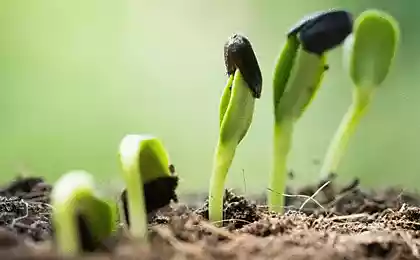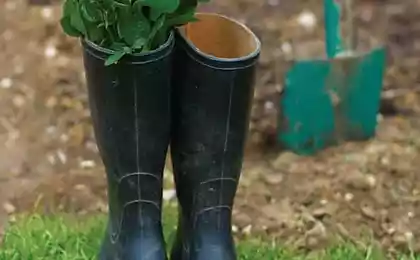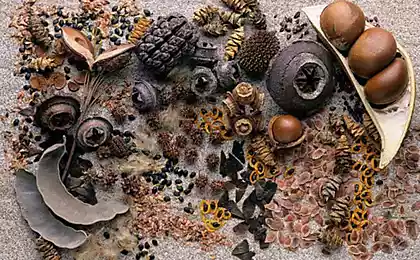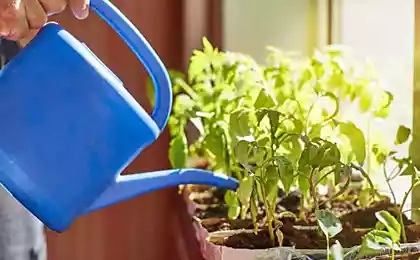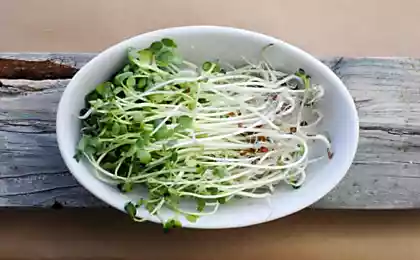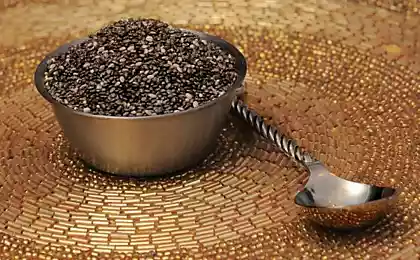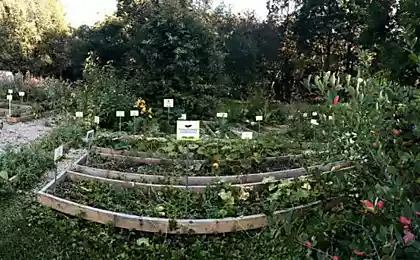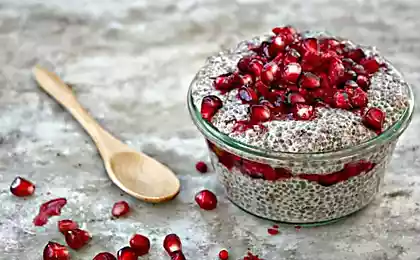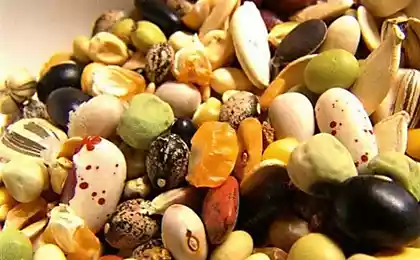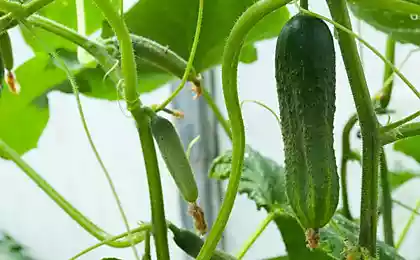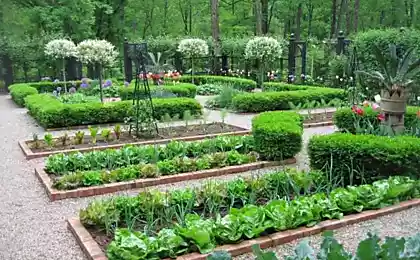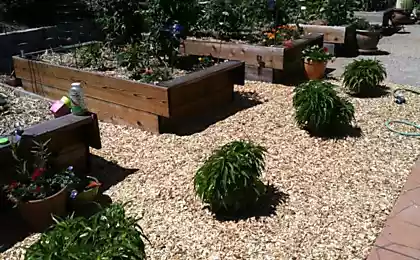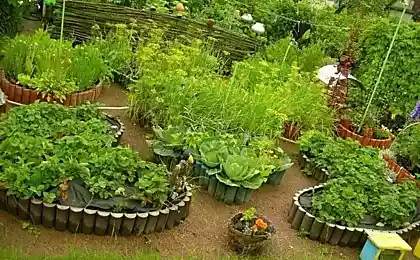451
Your seeds: how to grow, harvest, preserve
The gardeners noticed that the seeds grown on their own plot grow faster than their counterparts from a bright colorful package. Plants will yield no less.
Buying seeds is like a lottery. We will not blame manufacturers for dishonesty, they work according to standards. Let us not believe the merchants who claim that the seeds in white bags are of lower quality than the elegantly colored ones. The matter is in the climate and soils, growing conditions in each particular garden. So, we need to grow our own seeds, which are already adapted to life on our beds.
Is it difficult to grow seeds?
No, it's not hard. But the laws of seed production need to be known.
From seed to seed. Cucumber, peas, eggplant, beans, tomato, pepper, lettuce and dill are called annual crops, they give seeds in the year of sowing.
Carrots, parsley, celery, cabbage, parsnips, beets and onions are biennial plants. In the first year, they will give fruits, which in seed production are called queens. They are stored in winter in cellars, cellars, in the spring of the new year they are planted in the ground and by autumn they receive seeds.
Sorrel, onions of the batun, onions of fragrant, rhubarb are plants perennial. They give seeds many times.
All our vegetables are divided into cross-pollinating, self-pollinating and partially self-pollinating.
Carrots, onions, beets, all cabbage, cucumber and radish are cross-pollinating crops. It is important for them that pollen from one plant gets on the flowers of another. For example, to obtain parsnip seeds, five plants need to grow nearby. If you want to get seeds of carrots of several varieties, you need to create several plots with five queens of each variety.
Cross-pollination plants help bees or other insects. Therefore, plots with queens of different varieties should be placed in different corners of the garden, and the further they are from each other, the better. The best option is to grow seeds of only one variety.
In seed farms plots are located at a distance of almost a kilometer from each other, but between them do not leave black steam at the time of flowering. Let the weed grow, and better the forest belts.
Pepper and eggplant are partially self-pollinating plants. Their plots should be located one from another at a distance of 100 meters.
Delianks with queen plants of self-pollinating tomatoes, lettuce, beans and peas can be located only ten meters from each other.
Around the suburban areas grow many wild relatives of our vegetables. Wild marshmallow can pollinate turnips, wild sorrel is able to transfer its genes to sorrel cultured, wild radish will certainly make friends with radish. So we need to mow the weeds around the site without letting them bloom.
Cabbages can become overpollinated, so different varieties and types of cabbage should be separated from each other. Radice and radish can not be grown on the same plot to obtain seeds. This also applies to carrots dining and feed, beets dining and sugar.
Tomatoes can cross-pollinate, but their flowers have such a structure that self-pollination always occurs. Therefore, for example, growing on the same bed tomatoes varieties Sanka and Apple Russia will give seeds that have preserved the properties and characteristics of their variety by about 90%. But it is better to place beds with tomatoes at a short distance from each other.
Pepper and eggplant themselves pollinate their seeds in about half of the cases. This gardeners also noticed: from the seeds of sweet pepper growing next to spicy peppers with a surprise will grow. Everyone is familiar with the amazing shape of zucchini, similar to patissons.
Take a look at the plantings of queens in the areas of neighbors. If they grow seeds of the same crops, it is worth knowing which variety. It's unlikely to match yours. You will have to build temporary shelters for your plants. These are tunnels similar to those sold in stores to shelter seedlings in the spring. During the flowering of queens, a high tunnel will be an insulator. Its height should be about 1.5 meters.
In such a design, insects will not be able to get, you will have to do pollination manually - a brush for children's drawing creativity to transfer pollen, like a bee, early in the morning, when the flowers open. Tunnels can be removed when flowering is over.
The queen and the queen bee - what is the similarity? The quality and quantity of nutrients. The uterus is fed royal jelly so that it can sow many eggs. Seed plants in the first year and in the second should be fully fed to get quality seeds.
And thirst queen plants should not suffer. For cabbage, the period of formation of a kochan is important; for a tomato, the formation of fruits; for beets, watering matters all the vegetation; onions from black seeds require moisture at the very beginning of growth so that the thin tip of the feather does not turn yellow. Less water is required during flowering and seed ripening.
Seed plants should be healthy. Prevention is important here. Sick people should be removed. After all, it is more difficult to cope with an infection in a seed than to grow a healthy royal plant.
There should be no pests on seed plants - they will take the strength, weak seeds will turn out. However, spraying with poisons should be careful not to kill insects.
Now from the basics and theory, let’s move on to practical issues: how to get quality seeds of the most popular vegetables in your garden.
The plant is cross-pollinated, heat-loving. Sow in the soil, the temperature of which rose to +18 degrees. The soil should be light, airy, nutritious, neutral. On sour soil, you can not get good seeds. Maternal plants must be pinched over the fifth or sixth leaf, so that there are many female flowers. All ugly or damaged, any problem fruit should be removed from the plant. Leave no more than five, very similar to the described variety.
In our middle band, the testes mature 35-40 days after the formation of fruits (not small, which are removed for marination, but large, overgrown). The color changes, the green disappears, yellowness and winding cracks appear, as on the canvases of the old masters.
Seed fruits should hang on the plant for a long time until the peduncle dries. After removing them, you need another two weeks to store in a warm and dry room until the fruit becomes softer. Then you can choose the seeds.
Cut the fruits and clean the seeds in a plate together with mezga, store them in a plate for two days. When the fermentation is over, quality seeds will sink to the bottom. Carefully drain the mezga, wash the seeds (preferably in the sieve, so that they do not run away with water) and dry in the open air, in a dry ventilated place. If the street is damp or humid, then the room is under constant control, often stirring.
A little folk wisdom.
The testes of cucumber can be distinguished fruits of female and male types. They are clearly distinguishable in the cross section: the male has three seed chambers, the female has four chambers. Seeds should be taken from a four-chamber cucumber, but not all, but only from the upper half. Then there will be no hollow flowers and bitterness.
Experts can say that the cause of bitterness or only male flowers lies in sharp fluctuations in temperatures, that this can happen simply from a very hot summer. But the above hypothesis has the right to life, so is it worth adding another to the risks? Especially since bitterness is a property of old varieties.
One fruit produces about 12 grams of seeds – much more than 15 seeds from the purchase package.
The tomato plant is self-pollinating. To obtain the usual harvest, you can treat seedlings affected by a black leg. Well, less fruit will grow, immunity will weaken. For seed purposes, plants should be completely healthy. Therefore, it is necessary to sow in the purchased land, it is pre-disinfected. Seeds to cook. And engage in prevention: spray royal plants with any natural drugs that can cope with fungal diseases (and when growing in cassettes, and in the ground). In a permanent place, seedlings should be planted only with full confidence that there will be no frost. It is no good for queens to first die a little, and then waste their energy and time on recovery. Plants grow in one stem, stepchildren have no place! All forces must come in several fruits. Leave 4 brushes on the stalk. In early August, pinch the tops so that strength is not wasted on fruits that do not have time to grow and mature. The fruit ripens after about 60 days (depending on the variety and weather). To obtain seeds, you need to choose the most productive plants, most similar to the varietal description and picture on the package. Tomato fruits do not ripen at the same time, they should be harvested after 3 days. But all the fruits of the four brushes cannot be taken, only those that can ripen for the first four collections. Everyone else will go for sour cream salads. Fruits of milk ripeness can be overheated in boxes.
Don’t wait until the tomatoes are soft, it will reduce the quality of the seeds. Just well-ripe cut across the fruit and the narrow side of the spoon take out the seeds along with the juice. Let them stay in the bowl for a day, then rinse. Dry at a temperature above +8 degrees.
Do not take seeds from a tomato cut for food, even if its taste seems special!
One plant will give no more than 10 grams of seeds. Now you can see why they're expensive!
The pepper plant is partially self-pollinating. If only one type of pepper grows on the site, then bees or other lovers of pepper nectar will be able to bring pollen only of the flowers of your variety. If several varieties, then it is unlikely to get pure-grade seeds. Read everything that is written about tomatoes. Unless you need to water the peppers more often.
No matter how many fruits the plant is tied, no more than two (in the south - no more than four) should be left on the branches of the first three orders, all the rest should be removed in technical maturity. The fruit should be removed from the plant before the first threat of frost (no later than September 15). By this time, they should be painted according to the variety. For seed fruits, the age is determined: not less than 40 days.
You can predawn pepper in the room, but not on those windowsills where there is direct sunlight. You need to choose the seeds quickly, otherwise the quality will decrease.
One plant can produce about 8 grams of seeds.
The eggplant is partially self-pollinating. Everything about tomatoes and peppers is fair.
Leave only 2 fruits on the plant, the very first, the lowest. Remove only in the phase of biological ripeness (judging by the timing - 130-170 days from full shoots, depending on the precociousness of the variety). The color should change from the usual purple to brown, yellowish-gray, brown-yellow or brown. There is another way: look at the seeds, touch them. Seeds in biological ripeness are always solid.
It's about a month. Eggplant seeds are harder to remove than tomatoes and peppers. You need to gently grind the fruits, soak them in water (do not soak!) and grind through a sieve, separating mezga. You can't ferment!
Ten kilograms of fruit can produce 200 grams of seeds.
The plant is pollinated until the flower is opened, so from one plant the seeds are always clean, varietal. The whole mass of seeds collected may not be homogeneous, because there is no guarantee that a seed of another variety did not accidentally come across. Therefore, you need to monitor plants: remove those that have flowers of a different color; during the formation of pods, remove plants of shelling varieties. So that shoots do not lie down, you need to grow on supports.
Remove as soon as the beans start to turn yellow. Take off not with pods, but with plants, tie with sheaves and hang in sheds. Eat in bags, easily rolling roller, so as not to damage the seeds.
One plant can produce 15 grams of seeds.
Vegetable beans are self-pollinating plants. Sow only in warm soil after the disappearance of the threat of frost.
If there are plants among the bushes, remove them! Clean when the beans are yellow. Everything else is like peas.
One plant produces about 20 grams of seeds.
The signal for cleaning is blackening of the lower beans. Pull the stems! Collect them in sheaves and finish them in the barn.
One plant produces about 40 grams of seeds.
Radis Cross-pollinated plant. First you need to grow royal radishes, and then the seeds.
Radish is usually grown - just as for food. When the root crop of the early variety reaches a diameter of 2 centimeters, and the middle-early one - 3 centimeters, dig out. Botva cut, leaving the petals 4 centimeters long and the two youngest leaves in the center of the socket. Then dip the root vegetables in clay chatter and put in boxes, boxes. Store in a cool place until disembarkation.
Around the end of April, the queens should already be planted in the ground. Digging the hole is quite deep so that the plant easily fits in it, and the top was sprinkled with earth for 2 centimeters. Watering is a must! Has a shooter started forming? Feed it with phosphorus fertilizer. Keep away from cruciferous fleas, rapeseed, birds. Remove all non-standard plants.
Cleaning begins when the seeds are brown and the pods are light yellow. It takes 170 days to grow from seed to seed.
One plant produces about 25 grams of seeds.
The plant is self-pollinating. To obtain seeds in the middle strip, you need to grow through potted seedlings (in the modern version - in cassettes). In the ground plant at a distance of 30 centimeters from each other.
Protect preventive spraying from rot. Have you begun to form cocks or rosettes of leaves? Immediately remove all atypical plants, all patients, all who have arrows appeared too early. Leave only plants with dense heads or a powerful socket. Flower stems grew - again culling, now underdeveloped testes.
If the heads are dense, you need to make an incision with a cross on the top. Remove all lower leaves, not just yellowed and sick. The stems must be tied to the supports, otherwise they will fall. As soon as the inflorescences go brown, we must begin cleaning. Cut testicles to finish and dry in sheds for a week and a half.
One plant can produce 8 grams of seeds.
Dill. What is easier is to grow dill seeds! He's a scavenger in every garden.
However, there are many varieties of this plant that are very different from each other.
In the most modern bush varieties, internodes are shortened, lateral branches grow, the plant gives a lot of greenery. Such varieties for seeds are better grown in warm regions, because for the ripening of seeds, temperatures within +25 are needed. . . +29 degrees.
If your neighbors do not grow your variety, then the seeds will certainly not turn out varietal. It will not be the rate of growth of sockets, not the amount of aromatic substances ... Even diseases (and dill has many of them) plants will be more affected.
The same can be said about cilantro.
If all the subtleties of varietal signs are not interesting to the gardener, then you can collect your seeds without hassle - what has grown, then has grown. In other cases, read what is written about carrots.
Colored cabbage, broccoli Cross-pollinating crops. Everyone knows when these cabbages can be cut for casseroles and soups. At the same time, you can prepare the heads for seeds.
They are so arranged that they begin to diverge on their “legs” in different directions, and the very center holds the “form” for a long time. If it is warm and humid, then pests and pathogens of diseases settle in this strong middle. Mucous bacteriosis and others with it will not allow you to get seeds.
What do I do? Operation! We need to cut out the central part. And even some of the lateral shoots of the head are also cut, leaving only 5-6 lower ones. If the head is still dense, has not begun to open, then cut the lower shoots, and leave the central head. Even the heads that formed earlier than other plants need to be removed. All ugly, ugly, all green leaves, grown inside the head, also remove. Places of cuts to powder with crushed coal. Without surgical intervention can not do in any case.
These cabbages bloom for about a month. They must be tied to the stakes. Are the pods light yellow? So it's time to clean up. Seminal shoots should be cut without touching the cap, often in several receptions. Tie in bundles, hang in a shed, put rags under them, so as not to lose some of the seeds.
One plant can produce 50 grams of seeds.
How to get seeds of biennial vegetable crops? It will not be possible to do this in one season - in the first year such plants form only a queen, which will need to be preserved in winter so that the next summer it will give seeds.
White cabbage will have to go through three stages:
Growing queens is a familiar thing: it is the same as growing cabbage for salting, but these plants should be absolutely healthy, not gnawed by insects, without slugs inside the cock, without the moves of caterpillars of cabbages and whiteberries. And also - well-fed, with good immunity, so that in winter you do not get mushroom diseases that will not allow you to get seeds. After all, for food, such a head can be quite cleaned, and for seeds - it is impossible.
Selected plants for the tribe to dig with a shovel or pitchfork, preserving the roots, leaving the poker intact. Some of the lower old, yellowed leaves are removed.
If for salting, the noodles must survive the first frost in the field, then the queens are removed before frost, otherwise they will die in the basement, or mucous bacteriosis will appear when the plants are planted in the ground. The temperature in the basement is 0 ... + 1 degree. But queens do not immediately send for the winter, first keep in the barn a day, two, three, to see if everyone is fit for the tribe, and cool down a little.
For storage, special racks are made in the form of a grid with the size of the cells, which will allow the roots to look down and the heads to look up. As in a garden, only the soil will be air. Throughout the winter, you need to monitor, remove damaged leaves.
Spring has come, a month is left before landing in the ground - it's time to cook pots. It is necessary to cut them from the kochan with the apical kidney and bury the prepared plants.
Before planting, dip the roots in a clay chatter with the addition of mug and heteroauxin. In the ground to bury under the very head, compact it around the pot, water. To shelter from frost, hot sun. After half a month, remove the stalks and old leaves. Water, feed, protect, engage in the prevention of diseases.
Tied to stakes before flowering. All shoots that did not have time to open the flowers in time, remove. The plant, though cross-pollinated, but it is necessary to shake the bushes in dry weather. The seeds mature after about 2 months. Cleaning is like cauliflower.
One plant can produce 50 grams of seeds.
Carrots dining room, parsley, celery, parsnip, beets These cross-pollinated plants in the first year grow a socket of leaves and queen, in the second - throw out a strongly branched flower stalk on which seeds appear.
Beets, carrots, parsley, parsnip in the spring should be sown on beds, and celery should be grown by seedlings. Remove root crops until cold. Royal carrots, who have been under freezing (at a temperature below -3 degrees), die during storage. The best temperature for cleaning is +4 ... +5 degrees. The recommended weight of carrots is 120 grams, beets are 250 grams, but small root vegetables weighing more than 30 grams can also be used.
You need to trim the foam on the cone, leave the petals no longer than 1.5 centimeters. The temperature in the basement is 0 ... + 2 degrees. Poultry for storage can be poured with sand.
Poultry should be planted in well-heated soil in early spring or grown in greenhouses or warm beds, buried. Care for plantings is usual: time to weed, feed, water, loosen. Removing all weeds is a must because it is difficult to separate their seeds from the seeds of vegetable crops.
The signal for the beginning of harvesting carrots, parsley is the browning of umbrellas; in celery, seeds acquire a purple hue; in beets, 40% of glomeruli should become brown. All work to do in the morning, cut umbrellas to tie with sheaves, dose in the barn. Usually cut is carried out 2-3 times.
One queen carrot gives 25 grams of seeds, parsley - 30 grams, celery - 25 grams, beets - 50 grams.
To obtain seeds, it takes three years: in the first of the seeds, the sow is grown, in the second year, the queen is obtained from the sow, in the third year - the seeds. This culture is labor intensive. It is necessary to protect plants from pests and diseases for three years. One-year onions for seeds are grown in 2 years.
You need to remove the testes at the first appearance of burst boxes. Umbrellas cut together with an arrow 20 centimeters long, knit with sheaves. Hang in the sheds, lay a bag under them.
Collected, cleaned of garbage and dried seeds can simply be laid out on canvas bags, make tags with the inscription of culture, variety, year of receipt and, put in a box, take out in a cold pantry. Let them stay there until spring. It's the oldest way.
From modern there is one from Wiley: place the seeds in a glass jar, put powdered milk powder in a cloth over the seeds (the weight of the seeds and milk should be the same), close the jar and store it in the refrigerator or freezer.
Any storage does not cancel the pre-sowing treatment of seeds.
Seed producers and originators consider growing seeds on their own beds a game of breeders. Some of them are right, because it is quite difficult to get quality material. However, this is how the popular favorite varieties of vegetables were created. Tomatoes Biyskaya rose, Bull heart; Murom and Nezhin cucumbers ... Geranium Kiss tomatoes are a variety created by an Oregon farmer. Or here is the Kazan local tomato - it is after all folk selection, growing seeds on its site.
Gardeners and can not apply all methods of selection. Let only analytical selection and mass selection be available to them, let plants that are absolutely identical in characteristics grow out of the seeds collected, let the splitting of traits go on. Let the fruits of hybrids grow snares or bushes that can grab all the sores, let them!
The main thing is that seed production on the site is interesting. You can get lucky! And that's not how miracles happened.
And yet, it is necessary to start with the cultivation of seeds of self-pollinating crops - tomatoes, peas, lettuce. Learn from the simplest, from the basics, so as not to lose interest. published
P.S. And remember, just by changing our consumption, we change the world together!
Source: www.7dach.ru
Buying seeds is like a lottery. We will not blame manufacturers for dishonesty, they work according to standards. Let us not believe the merchants who claim that the seeds in white bags are of lower quality than the elegantly colored ones. The matter is in the climate and soils, growing conditions in each particular garden. So, we need to grow our own seeds, which are already adapted to life on our beds.
Is it difficult to grow seeds?
No, it's not hard. But the laws of seed production need to be known.
From seed to seed. Cucumber, peas, eggplant, beans, tomato, pepper, lettuce and dill are called annual crops, they give seeds in the year of sowing.
Carrots, parsley, celery, cabbage, parsnips, beets and onions are biennial plants. In the first year, they will give fruits, which in seed production are called queens. They are stored in winter in cellars, cellars, in the spring of the new year they are planted in the ground and by autumn they receive seeds.
Sorrel, onions of the batun, onions of fragrant, rhubarb are plants perennial. They give seeds many times.
All our vegetables are divided into cross-pollinating, self-pollinating and partially self-pollinating.
Carrots, onions, beets, all cabbage, cucumber and radish are cross-pollinating crops. It is important for them that pollen from one plant gets on the flowers of another. For example, to obtain parsnip seeds, five plants need to grow nearby. If you want to get seeds of carrots of several varieties, you need to create several plots with five queens of each variety.
Cross-pollination plants help bees or other insects. Therefore, plots with queens of different varieties should be placed in different corners of the garden, and the further they are from each other, the better. The best option is to grow seeds of only one variety.
In seed farms plots are located at a distance of almost a kilometer from each other, but between them do not leave black steam at the time of flowering. Let the weed grow, and better the forest belts.
Pepper and eggplant are partially self-pollinating plants. Their plots should be located one from another at a distance of 100 meters.
Delianks with queen plants of self-pollinating tomatoes, lettuce, beans and peas can be located only ten meters from each other.
Around the suburban areas grow many wild relatives of our vegetables. Wild marshmallow can pollinate turnips, wild sorrel is able to transfer its genes to sorrel cultured, wild radish will certainly make friends with radish. So we need to mow the weeds around the site without letting them bloom.
Cabbages can become overpollinated, so different varieties and types of cabbage should be separated from each other. Radice and radish can not be grown on the same plot to obtain seeds. This also applies to carrots dining and feed, beets dining and sugar.
Tomatoes can cross-pollinate, but their flowers have such a structure that self-pollination always occurs. Therefore, for example, growing on the same bed tomatoes varieties Sanka and Apple Russia will give seeds that have preserved the properties and characteristics of their variety by about 90%. But it is better to place beds with tomatoes at a short distance from each other.
Pepper and eggplant themselves pollinate their seeds in about half of the cases. This gardeners also noticed: from the seeds of sweet pepper growing next to spicy peppers with a surprise will grow. Everyone is familiar with the amazing shape of zucchini, similar to patissons.
Take a look at the plantings of queens in the areas of neighbors. If they grow seeds of the same crops, it is worth knowing which variety. It's unlikely to match yours. You will have to build temporary shelters for your plants. These are tunnels similar to those sold in stores to shelter seedlings in the spring. During the flowering of queens, a high tunnel will be an insulator. Its height should be about 1.5 meters.
In such a design, insects will not be able to get, you will have to do pollination manually - a brush for children's drawing creativity to transfer pollen, like a bee, early in the morning, when the flowers open. Tunnels can be removed when flowering is over.
The queen and the queen bee - what is the similarity? The quality and quantity of nutrients. The uterus is fed royal jelly so that it can sow many eggs. Seed plants in the first year and in the second should be fully fed to get quality seeds.
And thirst queen plants should not suffer. For cabbage, the period of formation of a kochan is important; for a tomato, the formation of fruits; for beets, watering matters all the vegetation; onions from black seeds require moisture at the very beginning of growth so that the thin tip of the feather does not turn yellow. Less water is required during flowering and seed ripening.
Seed plants should be healthy. Prevention is important here. Sick people should be removed. After all, it is more difficult to cope with an infection in a seed than to grow a healthy royal plant.
There should be no pests on seed plants - they will take the strength, weak seeds will turn out. However, spraying with poisons should be careful not to kill insects.
Now from the basics and theory, let’s move on to practical issues: how to get quality seeds of the most popular vegetables in your garden.
The plant is cross-pollinated, heat-loving. Sow in the soil, the temperature of which rose to +18 degrees. The soil should be light, airy, nutritious, neutral. On sour soil, you can not get good seeds. Maternal plants must be pinched over the fifth or sixth leaf, so that there are many female flowers. All ugly or damaged, any problem fruit should be removed from the plant. Leave no more than five, very similar to the described variety.
In our middle band, the testes mature 35-40 days after the formation of fruits (not small, which are removed for marination, but large, overgrown). The color changes, the green disappears, yellowness and winding cracks appear, as on the canvases of the old masters.
Seed fruits should hang on the plant for a long time until the peduncle dries. After removing them, you need another two weeks to store in a warm and dry room until the fruit becomes softer. Then you can choose the seeds.
Cut the fruits and clean the seeds in a plate together with mezga, store them in a plate for two days. When the fermentation is over, quality seeds will sink to the bottom. Carefully drain the mezga, wash the seeds (preferably in the sieve, so that they do not run away with water) and dry in the open air, in a dry ventilated place. If the street is damp or humid, then the room is under constant control, often stirring.
A little folk wisdom.
The testes of cucumber can be distinguished fruits of female and male types. They are clearly distinguishable in the cross section: the male has three seed chambers, the female has four chambers. Seeds should be taken from a four-chamber cucumber, but not all, but only from the upper half. Then there will be no hollow flowers and bitterness.
Experts can say that the cause of bitterness or only male flowers lies in sharp fluctuations in temperatures, that this can happen simply from a very hot summer. But the above hypothesis has the right to life, so is it worth adding another to the risks? Especially since bitterness is a property of old varieties.
One fruit produces about 12 grams of seeds – much more than 15 seeds from the purchase package.
The tomato plant is self-pollinating. To obtain the usual harvest, you can treat seedlings affected by a black leg. Well, less fruit will grow, immunity will weaken. For seed purposes, plants should be completely healthy. Therefore, it is necessary to sow in the purchased land, it is pre-disinfected. Seeds to cook. And engage in prevention: spray royal plants with any natural drugs that can cope with fungal diseases (and when growing in cassettes, and in the ground). In a permanent place, seedlings should be planted only with full confidence that there will be no frost. It is no good for queens to first die a little, and then waste their energy and time on recovery. Plants grow in one stem, stepchildren have no place! All forces must come in several fruits. Leave 4 brushes on the stalk. In early August, pinch the tops so that strength is not wasted on fruits that do not have time to grow and mature. The fruit ripens after about 60 days (depending on the variety and weather). To obtain seeds, you need to choose the most productive plants, most similar to the varietal description and picture on the package. Tomato fruits do not ripen at the same time, they should be harvested after 3 days. But all the fruits of the four brushes cannot be taken, only those that can ripen for the first four collections. Everyone else will go for sour cream salads. Fruits of milk ripeness can be overheated in boxes.
Don’t wait until the tomatoes are soft, it will reduce the quality of the seeds. Just well-ripe cut across the fruit and the narrow side of the spoon take out the seeds along with the juice. Let them stay in the bowl for a day, then rinse. Dry at a temperature above +8 degrees.
Do not take seeds from a tomato cut for food, even if its taste seems special!
One plant will give no more than 10 grams of seeds. Now you can see why they're expensive!
The pepper plant is partially self-pollinating. If only one type of pepper grows on the site, then bees or other lovers of pepper nectar will be able to bring pollen only of the flowers of your variety. If several varieties, then it is unlikely to get pure-grade seeds. Read everything that is written about tomatoes. Unless you need to water the peppers more often.
No matter how many fruits the plant is tied, no more than two (in the south - no more than four) should be left on the branches of the first three orders, all the rest should be removed in technical maturity. The fruit should be removed from the plant before the first threat of frost (no later than September 15). By this time, they should be painted according to the variety. For seed fruits, the age is determined: not less than 40 days.
You can predawn pepper in the room, but not on those windowsills where there is direct sunlight. You need to choose the seeds quickly, otherwise the quality will decrease.
One plant can produce about 8 grams of seeds.
The eggplant is partially self-pollinating. Everything about tomatoes and peppers is fair.
Leave only 2 fruits on the plant, the very first, the lowest. Remove only in the phase of biological ripeness (judging by the timing - 130-170 days from full shoots, depending on the precociousness of the variety). The color should change from the usual purple to brown, yellowish-gray, brown-yellow or brown. There is another way: look at the seeds, touch them. Seeds in biological ripeness are always solid.
It's about a month. Eggplant seeds are harder to remove than tomatoes and peppers. You need to gently grind the fruits, soak them in water (do not soak!) and grind through a sieve, separating mezga. You can't ferment!
Ten kilograms of fruit can produce 200 grams of seeds.
The plant is pollinated until the flower is opened, so from one plant the seeds are always clean, varietal. The whole mass of seeds collected may not be homogeneous, because there is no guarantee that a seed of another variety did not accidentally come across. Therefore, you need to monitor plants: remove those that have flowers of a different color; during the formation of pods, remove plants of shelling varieties. So that shoots do not lie down, you need to grow on supports.
Remove as soon as the beans start to turn yellow. Take off not with pods, but with plants, tie with sheaves and hang in sheds. Eat in bags, easily rolling roller, so as not to damage the seeds.
One plant can produce 15 grams of seeds.
Vegetable beans are self-pollinating plants. Sow only in warm soil after the disappearance of the threat of frost.
If there are plants among the bushes, remove them! Clean when the beans are yellow. Everything else is like peas.
One plant produces about 20 grams of seeds.
The signal for cleaning is blackening of the lower beans. Pull the stems! Collect them in sheaves and finish them in the barn.
One plant produces about 40 grams of seeds.
Radis Cross-pollinated plant. First you need to grow royal radishes, and then the seeds.
Radish is usually grown - just as for food. When the root crop of the early variety reaches a diameter of 2 centimeters, and the middle-early one - 3 centimeters, dig out. Botva cut, leaving the petals 4 centimeters long and the two youngest leaves in the center of the socket. Then dip the root vegetables in clay chatter and put in boxes, boxes. Store in a cool place until disembarkation.
Around the end of April, the queens should already be planted in the ground. Digging the hole is quite deep so that the plant easily fits in it, and the top was sprinkled with earth for 2 centimeters. Watering is a must! Has a shooter started forming? Feed it with phosphorus fertilizer. Keep away from cruciferous fleas, rapeseed, birds. Remove all non-standard plants.
Cleaning begins when the seeds are brown and the pods are light yellow. It takes 170 days to grow from seed to seed.
One plant produces about 25 grams of seeds.
The plant is self-pollinating. To obtain seeds in the middle strip, you need to grow through potted seedlings (in the modern version - in cassettes). In the ground plant at a distance of 30 centimeters from each other.
Protect preventive spraying from rot. Have you begun to form cocks or rosettes of leaves? Immediately remove all atypical plants, all patients, all who have arrows appeared too early. Leave only plants with dense heads or a powerful socket. Flower stems grew - again culling, now underdeveloped testes.
If the heads are dense, you need to make an incision with a cross on the top. Remove all lower leaves, not just yellowed and sick. The stems must be tied to the supports, otherwise they will fall. As soon as the inflorescences go brown, we must begin cleaning. Cut testicles to finish and dry in sheds for a week and a half.
One plant can produce 8 grams of seeds.
Dill. What is easier is to grow dill seeds! He's a scavenger in every garden.
However, there are many varieties of this plant that are very different from each other.
In the most modern bush varieties, internodes are shortened, lateral branches grow, the plant gives a lot of greenery. Such varieties for seeds are better grown in warm regions, because for the ripening of seeds, temperatures within +25 are needed. . . +29 degrees.
If your neighbors do not grow your variety, then the seeds will certainly not turn out varietal. It will not be the rate of growth of sockets, not the amount of aromatic substances ... Even diseases (and dill has many of them) plants will be more affected.
The same can be said about cilantro.
If all the subtleties of varietal signs are not interesting to the gardener, then you can collect your seeds without hassle - what has grown, then has grown. In other cases, read what is written about carrots.
Colored cabbage, broccoli Cross-pollinating crops. Everyone knows when these cabbages can be cut for casseroles and soups. At the same time, you can prepare the heads for seeds.
They are so arranged that they begin to diverge on their “legs” in different directions, and the very center holds the “form” for a long time. If it is warm and humid, then pests and pathogens of diseases settle in this strong middle. Mucous bacteriosis and others with it will not allow you to get seeds.
What do I do? Operation! We need to cut out the central part. And even some of the lateral shoots of the head are also cut, leaving only 5-6 lower ones. If the head is still dense, has not begun to open, then cut the lower shoots, and leave the central head. Even the heads that formed earlier than other plants need to be removed. All ugly, ugly, all green leaves, grown inside the head, also remove. Places of cuts to powder with crushed coal. Without surgical intervention can not do in any case.
These cabbages bloom for about a month. They must be tied to the stakes. Are the pods light yellow? So it's time to clean up. Seminal shoots should be cut without touching the cap, often in several receptions. Tie in bundles, hang in a shed, put rags under them, so as not to lose some of the seeds.
One plant can produce 50 grams of seeds.
How to get seeds of biennial vegetable crops? It will not be possible to do this in one season - in the first year such plants form only a queen, which will need to be preserved in winter so that the next summer it will give seeds.
White cabbage will have to go through three stages:
Growing queens is a familiar thing: it is the same as growing cabbage for salting, but these plants should be absolutely healthy, not gnawed by insects, without slugs inside the cock, without the moves of caterpillars of cabbages and whiteberries. And also - well-fed, with good immunity, so that in winter you do not get mushroom diseases that will not allow you to get seeds. After all, for food, such a head can be quite cleaned, and for seeds - it is impossible.
Selected plants for the tribe to dig with a shovel or pitchfork, preserving the roots, leaving the poker intact. Some of the lower old, yellowed leaves are removed.
If for salting, the noodles must survive the first frost in the field, then the queens are removed before frost, otherwise they will die in the basement, or mucous bacteriosis will appear when the plants are planted in the ground. The temperature in the basement is 0 ... + 1 degree. But queens do not immediately send for the winter, first keep in the barn a day, two, three, to see if everyone is fit for the tribe, and cool down a little.
For storage, special racks are made in the form of a grid with the size of the cells, which will allow the roots to look down and the heads to look up. As in a garden, only the soil will be air. Throughout the winter, you need to monitor, remove damaged leaves.
Spring has come, a month is left before landing in the ground - it's time to cook pots. It is necessary to cut them from the kochan with the apical kidney and bury the prepared plants.
Before planting, dip the roots in a clay chatter with the addition of mug and heteroauxin. In the ground to bury under the very head, compact it around the pot, water. To shelter from frost, hot sun. After half a month, remove the stalks and old leaves. Water, feed, protect, engage in the prevention of diseases.
Tied to stakes before flowering. All shoots that did not have time to open the flowers in time, remove. The plant, though cross-pollinated, but it is necessary to shake the bushes in dry weather. The seeds mature after about 2 months. Cleaning is like cauliflower.
One plant can produce 50 grams of seeds.
Carrots dining room, parsley, celery, parsnip, beets These cross-pollinated plants in the first year grow a socket of leaves and queen, in the second - throw out a strongly branched flower stalk on which seeds appear.
Beets, carrots, parsley, parsnip in the spring should be sown on beds, and celery should be grown by seedlings. Remove root crops until cold. Royal carrots, who have been under freezing (at a temperature below -3 degrees), die during storage. The best temperature for cleaning is +4 ... +5 degrees. The recommended weight of carrots is 120 grams, beets are 250 grams, but small root vegetables weighing more than 30 grams can also be used.
You need to trim the foam on the cone, leave the petals no longer than 1.5 centimeters. The temperature in the basement is 0 ... + 2 degrees. Poultry for storage can be poured with sand.
Poultry should be planted in well-heated soil in early spring or grown in greenhouses or warm beds, buried. Care for plantings is usual: time to weed, feed, water, loosen. Removing all weeds is a must because it is difficult to separate their seeds from the seeds of vegetable crops.
The signal for the beginning of harvesting carrots, parsley is the browning of umbrellas; in celery, seeds acquire a purple hue; in beets, 40% of glomeruli should become brown. All work to do in the morning, cut umbrellas to tie with sheaves, dose in the barn. Usually cut is carried out 2-3 times.
One queen carrot gives 25 grams of seeds, parsley - 30 grams, celery - 25 grams, beets - 50 grams.
To obtain seeds, it takes three years: in the first of the seeds, the sow is grown, in the second year, the queen is obtained from the sow, in the third year - the seeds. This culture is labor intensive. It is necessary to protect plants from pests and diseases for three years. One-year onions for seeds are grown in 2 years.
You need to remove the testes at the first appearance of burst boxes. Umbrellas cut together with an arrow 20 centimeters long, knit with sheaves. Hang in the sheds, lay a bag under them.
Collected, cleaned of garbage and dried seeds can simply be laid out on canvas bags, make tags with the inscription of culture, variety, year of receipt and, put in a box, take out in a cold pantry. Let them stay there until spring. It's the oldest way.
From modern there is one from Wiley: place the seeds in a glass jar, put powdered milk powder in a cloth over the seeds (the weight of the seeds and milk should be the same), close the jar and store it in the refrigerator or freezer.
Any storage does not cancel the pre-sowing treatment of seeds.
Seed producers and originators consider growing seeds on their own beds a game of breeders. Some of them are right, because it is quite difficult to get quality material. However, this is how the popular favorite varieties of vegetables were created. Tomatoes Biyskaya rose, Bull heart; Murom and Nezhin cucumbers ... Geranium Kiss tomatoes are a variety created by an Oregon farmer. Or here is the Kazan local tomato - it is after all folk selection, growing seeds on its site.
Gardeners and can not apply all methods of selection. Let only analytical selection and mass selection be available to them, let plants that are absolutely identical in characteristics grow out of the seeds collected, let the splitting of traits go on. Let the fruits of hybrids grow snares or bushes that can grab all the sores, let them!
The main thing is that seed production on the site is interesting. You can get lucky! And that's not how miracles happened.
And yet, it is necessary to start with the cultivation of seeds of self-pollinating crops - tomatoes, peas, lettuce. Learn from the simplest, from the basics, so as not to lose interest. published
P.S. And remember, just by changing our consumption, we change the world together!
Source: www.7dach.ru
